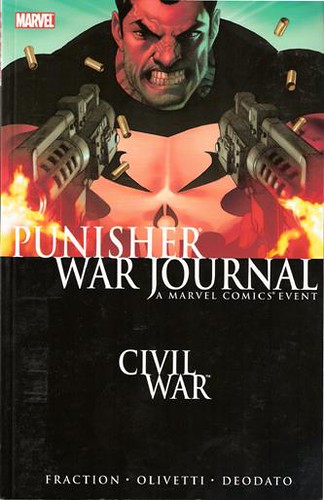Punisher War Journal, v. 1: Civil War
Collects: Punisher War Journal v. 2 #1-4 (2007)
Released: November 2007 (Marvel)
Format: 144 pages / color / $14.99 / ISBN: 9780785123156
What is this?: During Civil War, a battle between heroes in the Marvel Universe, the Punisher declares war on supervillains.
The culprits: Writer Matt Fraction, pencillers Ariel Olivetti (#1-3) and Mike Deodato (#4)
Writer Matt Fraction is a bit of conundrum for me. While he is the darling of certain corners of the Internet, I didn’t care for the first volume of his Casanova. Punisher War Journal, v. 1: Civil War doesn’t answer the question of where all the unabashed adoration is coming from either.
 I can see part of it. There are great moments and great lines. Stuart Clarke, a robotocist and Iron Man villain, has a flock of little robot Iron Men whom he alternately terrorizes and orders to do his bidding. A groggy Spider-Man, after he has been saved from the Jester and Jack o’ Lantern (really?) by the Punisher, tells his savior he can’t pay him, and when the Punisher says Spider-Man doesn’t have to pay, Spider-Man says, “Action is my reward too.” And pretty much the entirety of issue #4 — with the exception of the presence of the Prowler and Puma (really?) — is hilarious.
I can see part of it. There are great moments and great lines. Stuart Clarke, a robotocist and Iron Man villain, has a flock of little robot Iron Men whom he alternately terrorizes and orders to do his bidding. A groggy Spider-Man, after he has been saved from the Jester and Jack o’ Lantern (really?) by the Punisher, tells his savior he can’t pay him, and when the Punisher says Spider-Man doesn’t have to pay, Spider-Man says, “Action is my reward too.” And pretty much the entirety of issue #4 — with the exception of the presence of the Prowler and Puma (really?) — is hilarious.
But there are plenty of moments that strike me as wrong. (At times, Fraction’s entire Marvel Universe seems wrong, but I’m blaming that on Civil War.) The Bugle reluctantly endorsing the Punisher’s killings, for example, seems something the paper of J. Jonah Jameson would never do. The Punisher himself seems off as well; he mixes his steely, stoic demeanor with jokes that go flat, and he has his moments of comic fallibility. I don’t want the Punisher to be too personable and human; he never really has been either of those things. He’s a remorseless killer, and the closest he comes to jokes is the black humor about the villains’ deaths.
I didn’t care much for Civil War, the massive crossover that had Marvel’s superheroes fighting one another over civil rights, in either concept or what I saw of the execution. This doesn’t change my opinion on the matter, but it does give the Punisher a reason to enter superhero politics, which are usually settled at the end of a (metaphorical) gun. It also gives Fraction a chance to re-enact the Scourge of the Underworld storyline, which started in 1985 and climaxed in Captain America #318-20. In fact, #4 is a direct homage to Captain America #319, where the vigilante the Scourge kills a bar full of supervillains, most of whom are less than super. (The Punisher, admittedly, only destroys the bar and poisons its occupants; we don’t know the fates of his targets.)
I’m not exactly sure I see the point of killing third-rate villains. The original Scourge storyline was supposed to thin out the ranks of the incompetent, but their numbers exploded in the ‘90s, and even some killed in the massacre at the Bar with No Name have returned. I don’t even think killing these long-time punching bags will have much emotional impact. That being said, I don’t care for the Punisher killing classic Silver Age villains, even if they’re goofy. It just makes me dislike Fraction and the Punisher, because idiots like the Jester and Stilt-Man are weak, easy targets. Go after those disposable ‘90s villains, especially ones that clogged the Spider-Man books at the time. Man, those were awful.
Most of the art is provided by Ariel Olivetti, but his art leaves me cold. It appears to be painted, but it makes his characters look like motionless cutouts on a dark background. The colors are a bit washed out as well. Neither particularly fits for the title; the Punisher is a figure of action, in a world of blacks, whites, and arterial reds. Also, although I have nothing to say about Fraction making SHIELD agent G.W. Bridge a Muslim, I don’t like Olivetti’s design of Bridge, making him a paunchy old man — albeit a giant old man.
On the other hand, I love Mike Deodato’s gorgeous work on #4. It is a series of crowd scenes, but that’s all right; I can generally identify who’s who without gratuitous exposition, and everyone looks good. Especially Princess Python, one of my favorite Steve Ditko creations. I love Ditko’s work, but the Princess has never looked as good as she does here.
The price is a bit steep, considering the content. $15 for only 4 issues, even if one is supersized, is too much, and adding the black and white edition of #1 (which was actually released before the regular #1) doesn’t help much.
I really was on the fence about this one, but at that price, I can’t recommend Punisher War Journal, v. 1.
Rating: ![]()
![]() (1.5 of 5)
(1.5 of 5)
Labels: 1.5, Ariel Olivetti, Civil War, Marvel, Matt Fraction, Mike Deodato, Punisher




0 Comments:
Post a Comment
<< Home